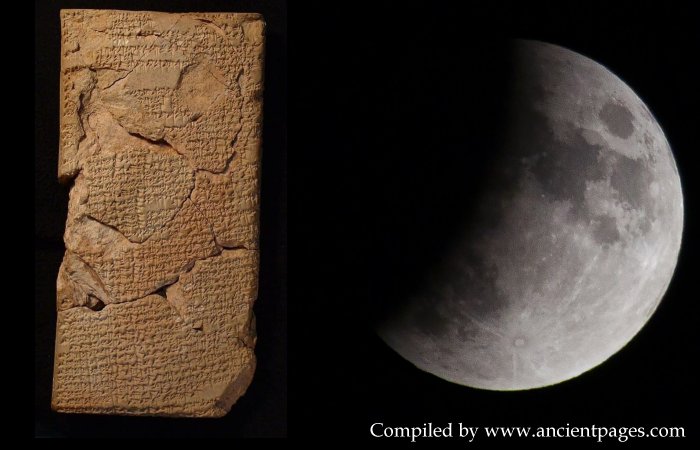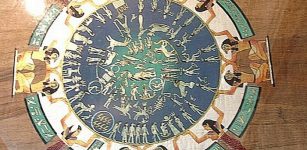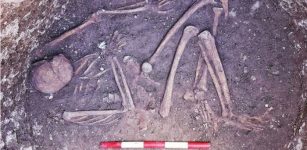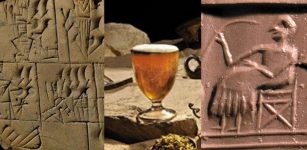4,000-Year-Old Babylonian Tablets Finally Deciphered, Revealing Dangerous Future Predictions
Conny Waters - AncientPages.com - For over a century, the British Museum has housed four ancient clay tablets discovered in the region now known as Iraq. Recently, two scholars have successfully deciphered the cuneiform inscriptions, revealing ominous prophecies.
Left: Babylonian clay tablet. Credit: The Trustees of the British Museum - Right: Moon eclipse. Credit: dexmac - Pixabay. Image compilation by AncientPages.com
Mesopotamians viewed writing as a divine gift, representing power and knowledge. The development of writing, which occurred between 5000 BC and 2000 BC, served multiple purposes: maintaining financial records, documenting religious ceremonies and scientific advancements, and chronicling extraordinary events now recognized as historical accounts.
Approximately 5,000 years ago, the inhabitants of Mesopotamia invented a system of writing to document and convey diverse forms of information. Cuneiform tablets, originated by the Sumerian civilization, represent one of the earliest writing systems.
A new study in the Journal of Cuneiform Studies reveals how ancient Mesopotamians viewed lunar movements as omens of impending disaster.
The peoples of Babylonia and other parts of Mesopotamia analyzed lunar eclipses by examining timing, shadow patterns, duration, and dates. This data was then used to predict future events.
Researchers believe the recently decoded tablets originated from Sippar, a city that thrived in ancient Babylonia.
According to researchers led by Andrew George, emeritus professor of Babylonian at the University of London, these are the oldest known records of lunar eclipse omens.
One decrypted tablet warns that “if an eclipse becomes obscured from its center all at once [and] clear all at once: a king will die, destruction of Elam.”
In ancient times, Elam, a region in southern Iran and Iraq, was part of Mesopotamia. Another tablet predicts the "downfall of Subartu and Akkad," both regions of Mesopotamia at the time, if "an eclipse begins in the south and then clears." Other ominous predictions include an attack on the land by a locust swarm, losses of cattle, and the fall of a "large army."
The Babylonians excelled in astronomy and valued it highly. They contributed to many modern constellations and kept detailed records of celestial events, believing these could predict the future.
These predictions stemmed from observing correlations between eclipses and subsequent disasters.
The MUL.APIN texts represent the earliest known astronomical records from the Near East. Dating back to approximately 1200 B.C., they consist of a series of small, palm-sized clay tablets. They contain valuable information on star positions, astronomical phenomena, and patterns of stellar appearances.
By the late 5th century B.C., Babylonian astronomers had significantly advanced their observational techniques. They established a sophisticated system using reference stars and zodiac constellations to standardize and simplify their astronomical observations. This development marked a crucial step in astronomical record-keeping and analysis evolution.
Notably, these ancient Babylonian astronomers are credited with creating the prototype of the astrological zodiac still in use today. This early zodiac version laid the foundation for subsequent astrological systems and continues to influence modern astrology.
Ancient astrologers likely used historical events to create a system linking eclipse features to specific omens, believing in a divine celestial code. Notably, Babylonians didn't accept these predictions as inevitable. For omens predicting a monarch's death, they consulted oracles through animal entrail examination. If threats were perceived, rituals were performed to negate the unfavorable prediction and prevent disaster.
Credit: The Trustees of the British Museum
The Babylonians were brilliant at astronomy, valuing it highly. They contributed to many modern constellations and kept detailed records of celestial events, believing these could predict the future.
These predictions stemmed from observing correlations between eclipses and subsequent disasters. Ancient astrologers likely used historical events to create a system linking eclipse features to specific omens, believing in a divine celestial code. Notably, Babylonians didn't accept these predictions as inevitable. For omens predicting a monarch's death, they consulted oracles through animal entrail examination. If threats were perceived, rituals were performed to negate the unfavorable prediction and prevent disaster.
These ancient peoples believed that celestial events were signs sent by the gods to warn about the fates of communities and their rulers.
"Those who advised the king kept watch on the night sky and would match their observations with the academic corpus of celestial-omen texts," George and his colleague Junko Taniguchi wrote in their paper.
Written by Conny Waters - AncientPages.com Staff Writer






















